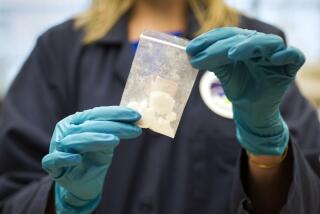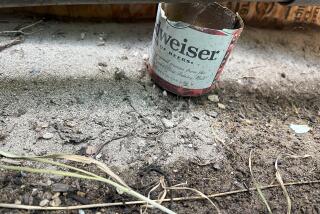Stolen Fertilizer Used to Make Drugs
- Share via
BILLINGS, Mont. — Charlie Bumgarner didn’t even know at first that thieves had been just feet from his farmhouse. It wasn’t until he spotted the siphon hoses near his two big fertilizer tanks that he realized he’d been ripped off.
“My father and grandfather had people steal fuel or tools,” said Bumgarner. “This is something we’ve never had to deal with before.”
Farmers like Bumgarner have become popular targets of criminals who steal anhydrous ammonia fertilizer to make the drug methamphetamine. They steal it in such small amounts that thefts often go unnoticed. And officials admit they have had little success in curbing the problem.
But Bill Mercer, the U.S. attorney for Montana, said that could change in the next six months when officials launch a public awareness campaign.
“We’ve raised a lot of attention about meth. Now, we’re at a point where we’d like to do more specialized training with this narrower focus,” he said.
County sheriffs in north-central Montana, one area hit hard by fertilizer thefts, say they’ll take what help they can get to catch thieves.
“We’re pursuing them as best as we can. But you have to take into account, a lot of these [theft] sites get very little traffic,” said Capt. Dan Smrdel of the Cascade County sheriff’s office. “Catching someone in the act is an exception. They can see you coming for miles.”
Anhydrous ammonia is close to pure nitrogen and is used on a wide variety of crops to increase growth. In Montana, it is often applied in the fall or early spring.
Meth-makers mix it with ingredients such as paint thinner and cold medicine to make what police call “poor man’s cocaine.” The Drug Enforcement Administration has called methamphetamine the fastest-growing U.S. drug threat.
Thieves have become increasingly brazen, sneaking at night onto farms and storage sites kept by chemical dealerships and helping themselves to samples from 1,000-gallon tanks like those on Bumgarner’s farm.
They only need a little--often less than a gallon for a vat of meth--and just a few minutes to get it. Often they leave no trace behind. Other times, broken tank valves, spliced fences and dangling hoses provide clues to the thefts.
Kathy Mathers, a spokeswoman for the Fertilizer Institute, a Washington-based trade organization, said the thefts have occurred just about everywhere there are isolated farms or storage sites.
“It’s something we’ve seen happen anywhere the product is sold at the retail level,” she said.
Police and Montana agricultural officials have been trying to alert more farmers to the problem and ask for their help. An important step they can take, authorities say, is to add extra security at their tanks and watch out for their neighbors’ tanks.
“There’s only so much each of us can do,” Long said.
“The problem is the desire for the drug,” Mathers added. “It causes people to basically forget they have lives.... And, in the case of ammonia, risk their lives to get it.”
Russ Miner, fertilizer manager at United Agri Products in Great Falls, warns of the danger of the chemical to anyone who isn’t trained to handle it.
“It’s kind of amazing. These guys that are taking it, if you get it on your bare skin, it burns you,” he said. “You just never hear about anyone ending up in the hospital.”
Frank Schumacher said a major fear for him is having a thief get hurt at one of his storage sites. Thefts, he said, have occurred consistently over the last three years at the rural tank site of Farmers Union Oil Co. near Great Falls, despite fences, lights and motion sensors.
“They cut locks, open valves, cut fences. Those are things we’ve had to absorb,” Schumacher said, estimating the financial sting at $5,000. More significant, he said, is the time spent checking sites and sometimes having to rouse employees from bed to do it.
Chouteau County Sheriff Doug Williams and his deputies, who devote about 15% of their time to the thefts and other meth-related crimes, rely heavily on help from the public.
“We don’t see this trend stopping anytime soon, but we’re not going to give up. The results of giving up are not good,” he said.
More to Read
Sign up for Essential California
The most important California stories and recommendations in your inbox every morning.
You may occasionally receive promotional content from the Los Angeles Times.













